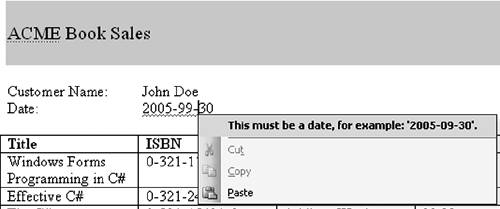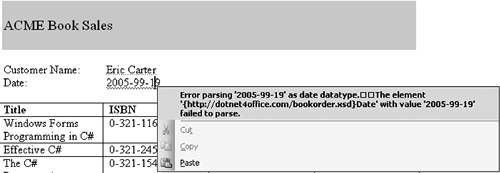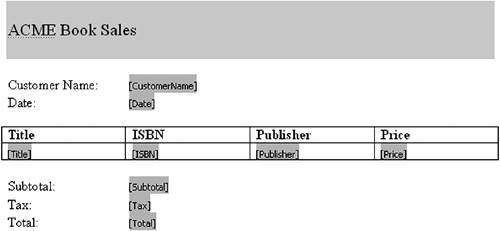The XML Options Dialog
The XML Options dialog shown in Figure 22-11 has three categories of options: XML save options, Schema validation options, and XML view options. These options are applied and saved at the document leveldifferent documents can have different sets of XML options. For XML save options, checking the Save data only option makes it so when you save the document as XML it will save the XML mapped into the document rather than saving the document in WordML format. The Apply custom transform option lets you specify an XSLT file to apply when you save the document. This feature is the inverse of the import XSLT file we considered earlier and is beyond the scope of this book.
The schema validation options let you control the way Word validates the document against the attached schema. With Validate document against attached schemas checked, Word validates the XML data in the document against the attached schema. If Hide schema violations in this document is not checked, Word displays squiggly lines under data that does not conform to the schema being used in the document. For example, in our book order document, consider what happens if we type an invalid date for the date of the order. Word displays a squiggly line under the date. If you right-click the squiggly line, you get a schema validation error, as shown in Figure 22-28.
Figure 22-28. A schema validation error for an illegal date.

We have already considered the Ignore mixed content option and the necessity of turning this option on when you intermix formatting and labels with the XML that is mapped into the document. The Allow saving as XML even if not valid will let you save invalid XMLyou typically should not check this option. Although Word will let you construct a document with multiple schemas attached that generate invalid XML, this prevents you from using features such as the XSLT feature and VSTO programming model features.
The XML view options section has some additional options for how Excel displays XML information. The Hide namespace alias in XML Structure task pane makes it so that the XML structure tree view does not display the namespace prefix before element names. For example, if the namespace is ns1 and the element is CustomerName, unchecking this option will result in Word displaying ns1:CustomerName in the tree view. Checking this option will result in Word displaying CustomerName.
Show advanced XML error messages shows advanced schema validation errors. This is useful during development of the document when you want to see the exact error message being returned by Word's XML validator. But these messages are not very friendly for end users, so you should be sure to turn this option off before you deploy your document. Figure 22-29 shows the error display for an illegal date when advanced XML error messages are turned on.
Figure 22-29. An "advanced" schema validation error for an illegal date.

Show placeholder text for all empty elements is an option you will almost always want to turn on before you deploy your document to end users. In a deployed document, you will typically not want to have the XML tags displayed because this is busy and confusing to the user of your document. But when the data within an XML tag is empty, it is impossible for the user of your document to know where to enter data. If you turn on the Show placeholder text for all empty elements, Word displays the name of the fields that need to be filled in so the user of the document can click the field name and type (see Figure 22-30). We have emptied out all the data between tags, but the placeholder text makes it clear to the user of the document where to enter data.
Figure 22-30. A document with Show placeholder text for all empty elements turned on.

Part One. An Introduction to VSTO
An Introduction to Office Programming
- Why Office Programming?
- Office Object Models
- Properties, Methods, and Events
- The Office Primary Interop Assemblies (PIAs)
- Conclusion
Introduction to Office Solutions
- The Three Basic Patterns of Office Solutions
- Office Automation Executables
- Office Add-Ins
- Code Behind a Document
- Conclusion
Part Two. Office Programming in .NET
Programming Excel
- Ways to Customize Excel
- Programming User-Defined Functions
- Introduction to the Excel Object Model
- Conclusion
Working with Excel Events
Working with Excel Objects
- Working with Excel Objects
- Working with the Application Object
- Working with the Workbooks Collection
- Working with the Workbook Object
- Working with the Worksheets, Charts, and Sheets Collections
- Working with Document Properties
- Working with the Windows Collections
- Working with the Window Object
- Working with the Names Collection and Name Object
- Working with the Worksheet Object
- Working with the Range Object
- Special Excel Issues
- Conclusion
Programming Word
Working with Word Events
Working with Word Objects
- Working with Word Objects
- Working with the Application Object
- Working with the Dialog Object
- Working with Windows
- Working with Templates
- Working with Documents
- Working with a Document
- Working with the Range Object
- Working with Bookmarks
- Working with Tables
- Conclusion
Programming Outlook
- Ways to Customize Outlook
- Introduction to the Outlook Object Model
- Introduction to the Collaboration Data Objects
- Conclusion
Working with Outlook Events
Working with Outlook Objects
- Working with Outlook Objects
- Working with the Application Object
- Working with the Explorers and Inspectors Collections
- Working with the Explorer Object
- Working with the Inspector Object
- Working with the NameSpace Object
- Working with the MAPIFolder Object
- Working with the Items Collection
- Properties and Methods Common to Outlook Items
- Outlook Issues
- Conclusion
Introduction to InfoPath
- What Is InfoPath?
- Getting Started
- Form Security
- Programming InfoPath
- Data Source Events
- Form Events, Properties, and Methods
- Conclusion
Part Three. Office Programming in VSTO
The VSTO Programming Model
- The VSTO Programming Model
- VSTO Extensions to Word and Excel Objects
- Dynamic Controls
- Advanced Topic: Dynamic Host Items
- Advanced Topic: Inspecting the Generated Code
- VSTO Extensions to the Word and Excel Object Models
- Conclusion
Using Windows Forms in VSTO
- Using Windows Forms in VSTO
- Introduction
- Adding Windows Forms Controls to Your Document
- Writing Code Behind a Control
- The Windows Forms Control Hosting Architecture
- Properties Merged from OLEObject or OLEControl
- Adding Controls at Runtime
- Conclusion
Working with Actions Pane
Working with Smart Tags in VSTO
- Introduction to Smart Tags
- Creating Document-Level Smart Tags with VSTO
- Creating Application-Level Smart Tags
- Conclusion
VSTO Data Programming
- VSTO Data Programming
- Creating a Data-Bound Customized Spreadsheet with VSTO
- Creating a Data-Bound Customized Word Document with VSTO
- Datasets, Adapters, and Sources
- Another Technique for Creating Data-Bound Spreadsheets
- Caching Data in the Data Island
- Advanced ADO.NET Data Binding: Looking Behind the Scenes
- Binding-Related Extensions to Host Items and Host Controls
- Conclusion
Server Data Scenarios
- Populating a Document with Data on the Server
- Using ServerDocument and ASP.NET
- A Handy Client-Side ServerDocument Utility
- The ServerDocument Object Model
- Conclusion
.NET Code Security
- .NET Code Security
- Code Access Security Versus Role-Based Security
- Code Access Security in .NET
- Location, Location, Location
- Strong Names
- Publisher Certificates
- Trusting the Document
- Deploying Policy to User Machines
- Conclusion
Deployment
- Deployment
- VSTO Prerequisites
- Deploying to an Intranet Shared Directory or Web Site
- Local Machine Deployment Without a Deployment Manifest
- Editing Manifests
- Creating Setup Packages
- Advanced Topic: Deploying Network Solutions to Be Cached Locally
- Conclusion
Part Four. Advanced Office Programming
Working with XML in Excel
- Introduction to Excels XML Features
- Introduction to XML Schema Creation in Visual Studio
- An End-to-End Scenario
- Advanced XML Features in Excel
- Excel-Friendly XML Schemas
- VSTO Support for Excel Schema Mapping
- Conclusion
Working with XML in Word
- Introduction to Words XML Features
- An End-to-End Scenario: Creating a Schema and Mapping It into a Word Document
- Exporting the Mapped XML in the Document to an XML Data File
- Importing an XML Data File into the Mapped Document
- The XML Options Dialog
- VSTO Support for Word Schema Mapping
- VSTO Support for the WordML File Format
- Conclusion
Developing COM Add-Ins for Word and Excel
- Introduction to Add-Ins
- Scenarios for Using Add-Ins
- How a COM Add-In Is Registered
- Implementing IDTExtensibility2
- Writing a COM Add-In Using Visual Studio
- The Pitfalls of MsCoree.dll
- COM Interop and Regasm.exe
- Shimming: A Solution to the Problems with MsCoree.dll
- Conclusion
Creating Outlook Add-Ins with VSTO
EAN: N/A
Pages: 214
